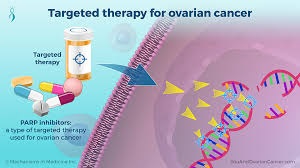OVARIAN CANCER TREATMENTS

Ovarian cancer is a serious and complex disease that requires a multifaceted approach to treatment. With advances in medical science, various treatment options are available, each tailored to address the unique needs of the patient based on the stage of the cancer and their overall health. This guide explores the main treatment approaches for ovarian cancer, including surgery, chemotherapy, radiation therapy, and targeted therapy. We will also discuss how treatment choices are made and highlight the crucial role of palliative care for patients with advanced-stage ovarian cancer.
TREATMENT APPROACHES FOR OVARIAN CANCER
Ovarian cancer treatment often involves a combination of therapies, each playing a distinct role in managing the disease. The choice of treatment depends on various factors, including the cancer stage, the patient’s overall health, and personal preferences.
1. Surgery:

Surgery is a cornerstone in the treatment of ovarian cancer. The primary goal of surgical intervention is to remove as much of the cancerous tissue as possible. This approach is typically considered when the cancer is localized and has not spread extensively.
Types of Surgery:
- Debulking Surgery: This is the most common surgical procedure for ovarian cancer. It involves the removal of the ovaries, uterus, and other affected tissues. The aim is to reduce the tumor burden and improve the effectiveness of subsequent treatments [1].
- Oophorectomy: This surgery involves the removal of one or both ovaries. It may be performed as part of a debulking procedure or as a preventive measure in women at high risk for ovarian cancer [2].
- Salpingo-oophorectomy: This procedure includes the removal of the ovaries and the fallopian tubes. It is often performed when the cancer is detected at an early stage and aims to prevent the cancer from spreading further [3].
Surgery is generally recommended for women with early-stage ovarian cancer and can significantly improve prognosis. However, it is not always suitable for advanced-stage cancers or for patients who are not in good overall health.
2. Chemotherapy:

Chemotherapy is a systemic treatment that uses drugs to kill cancer cells throughout the body. It is often administered after surgery to eliminate any remaining cancer cells and reduce the risk of recurrence.
Common Chemotherapy Regimens:
- Carboplatin and Paclitaxel: This combination is frequently used for treating ovarian cancer. Carboplatin is a platinum-based drug that interferes with DNA replication, while Paclitaxel inhibits cell division [4].
- Intraperitoneal Chemotherapy: In some cases, chemotherapy drugs are administered directly into the abdominal cavity. This approach can be more effective for targeting cancer cells that remain in the abdominal area after surgery [5].
Chemotherapy can be effective in shrinking tumors and managing symptoms, but it often comes with side effects such as nausea, fatigue, and hair loss. Managing these side effects is an essential part of the treatment process.
3. Radiation Therapy:

Radiation therapy uses high-energy rays to target and destroy cancer cells. It is less commonly used for ovarian cancer compared to other cancers but may be employed in specific situations.
Types of Radiation Therapy:
- External Beam Radiation: This involves directing radiation from outside the body to the tumor site. It is usually used to treat localized cancer or to manage symptoms [6].
- Brachytherapy: In this approach, a radioactive source is placed inside or very close to the tumor. Brachytherapy is rarely used for ovarian cancer but might be considered for specific cases [7].
Radiation therapy is typically used when the cancer has recurred or when surgery is not feasible. It is often combined with other treatments to enhance overall effectiveness.
4. Targeted Therapy:

Targeted therapy involves using drugs that specifically target cancer cells while minimizing damage to normal cells. This approach is based on understanding the genetic and molecular characteristics of the cancer.
Examples of Targeted Therapy:
- Bevacizumab (Avastin): This drug inhibits the growth of blood vessels that supply tumors, thereby slowing down tumor growth [8].
- PARP Inhibitors: These drugs, such as Olaparib and Niraparib, are used for cancers with specific genetic mutations (BRCA1/2). They work by interfering with the cancer cells’ ability to repair DNA damage [9].
Targeted therapies are generally used for advanced-stage ovarian cancer or in cases where the cancer has specific genetic markers. They offer a more personalized treatment approach and can be less toxic than traditional chemotherapy.
CHOOSING THE RIGHT TREATMENT

The choice of treatment for ovarian cancer is influenced by several factors:
1. Cancer Stage:
The stage of ovarian cancer is one of the primary determinants in deciding the appropriate treatment. Early-stage cancers (Stage I and II) may be treated primarily with surgery, sometimes followed by chemotherapy to reduce the risk of recurrence. Advanced-stage cancers (Stage III and IV) typically require a combination of surgery, chemotherapy, and possibly targeted therapy or radiation, depending on the extent of the disease [10].
2. Overall Health:
The patient’s overall health and medical history play a crucial role in determining the suitable treatment approach. For instance, patients with significant comorbidities or those who are not physically robust may not be ideal candidates for aggressive treatments like extensive surgery or certain chemotherapy regimens. In such cases, treatment plans are adjusted to balance efficacy with the patient’s ability to tolerate the therapy [11].
3. Personal Preferences:
Patient preferences and values are also considered when making treatment decisions. Some patients may prioritize quality of life over aggressive treatment, while others may opt for more intensive therapy with the hope of achieving remission. Healthcare providers work closely with patients to understand their preferences and make informed decisions that align with their goals [12].
IMPORTANCE OF PALLIATIVE CARE FOR PATIENTS WITH OVARIAN CANCER

For patients with advanced-stage ovarian cancer, palliative care becomes a crucial component of the overall treatment strategy. Palliative care focuses on providing relief from symptoms, pain, and stress associated with the disease and its treatment.
Key Aspects of Palliative Care:
- Symptom Management: Palliative care aims to manage symptoms such as pain, nausea, and fatigue, improving the patient’s quality of life. This may involve medications, physical therapy, and other supportive measures [13].
- Emotional and Psychological Support: Coping with advanced cancer can be emotionally challenging. Palliative care teams provide psychological support to help patients and their families navigate the emotional impact of the disease [14].
- Coordination of Care: Palliative care teams work alongside oncologists to ensure that all aspects of the patient’s care are coordinated. This includes addressing any issues related to treatment side effects and overall well-being [15].
- Support for Families: Palliative care also supports families by providing guidance on how to care for their loved ones and addressing any concerns they may have about the patient’s condition and care [16].
Palliative care is not limited to end-of-life situations; it can be integrated at any stage of the cancer journey to enhance the patient’s comfort and well-being.
CONCLUSION.
Ovarian cancer treatment involves a diverse range of approaches, including surgery, chemotherapy, radiation therapy, and targeted therapy. Each treatment option plays a distinct role in managing the disease, and the choice of treatment depends on the cancer stage, the patient’s overall health, and personal preferences. For patients with advanced-stage ovarian cancer, palliative care is essential in managing symptoms and improving quality of life.
By understanding the available treatment options and working closely with healthcare providers, patients can make informed decisions that best suit their individual needs and circumstances. As research and treatment options continue to evolve, the goal remains to provide the best possible outcomes and support for women battling ovarian cancer.
REFERENCES:
- American Cancer Society. (2023). Surgery for Ovarian Cancer. Retrieved from American Cancer Society
- National Cancer Institute. (2022). Types of Surgery for Ovarian Cancer. Retrieved from National Cancer Institute
- Mayo Clinic. (2023). Oophorectomy: Overview and Procedure. Retrieved from Mayo Clinic
- Cancer Research UK. (2022). Chemotherapy for Ovarian Cancer. Retrieved from Cancer Research UK
- Society of Gynecologic Oncology. (2023). Intraperitoneal Chemotherapy for Ovarian Cancer. Retrieved from Society of Gynecologic Oncology
- American Society for Radiation Oncology. (2022). Radiation Therapy for Ovarian Cancer. Retrieved from ASTRO
- The Lancet Oncology. (2021). Brachytherapy in Ovarian Cancer: Current Practices. Retrieved from The Lancet Oncology
- U.S. Food and Drug Administration. (2023). Bevacizumab (Avastin) for Ovarian Cancer. Retrieved from FDA
- National Comprehensive Cancer Network. (2023). PARP Inhibitors in Ovarian Cancer Treatment. Retrieved from NCCN
- American Cancer Society. (2023). Ovarian Cancer Stages and Treatment. Retrieved from American Cancer Society
- Cleveland Clinic. (2023). Treatment Planning for Ovarian Cancer. Retrieved from Cleveland Clinic
- Mayo Clinic. (2023). Choosing Treatment for Ovarian Cancer. Retrieved from Mayo Clinic
- Palliative Care Foundation. (2023). Managing Symptoms with Palliative Care. Retrieved from Palliative Care Foundation
- Cancer Support Community. (2023). Emotional Support for Cancer Patients. Retrieved from Cancer Support Community
- National Institute on Aging. (2023). Coordinating Cancer Care. Retrieved from NIA
- Family Caregiver Alliance. (2023). Supporting Families of Cancer Patients. Retrieved from Family Caregiver Alliance